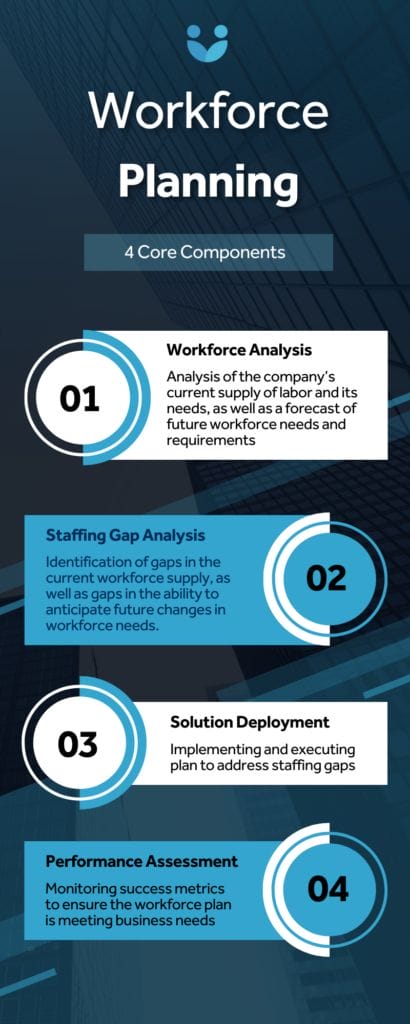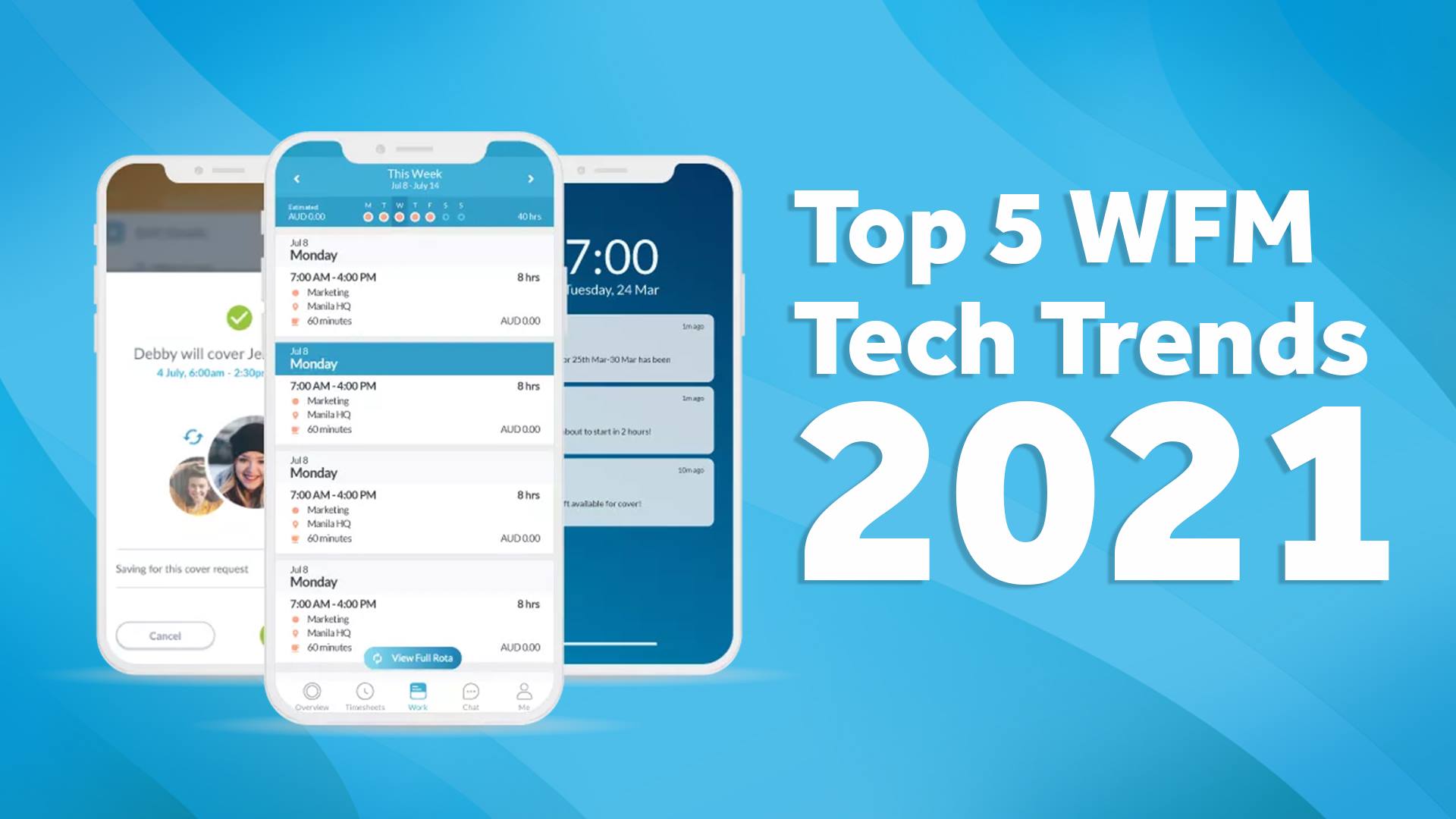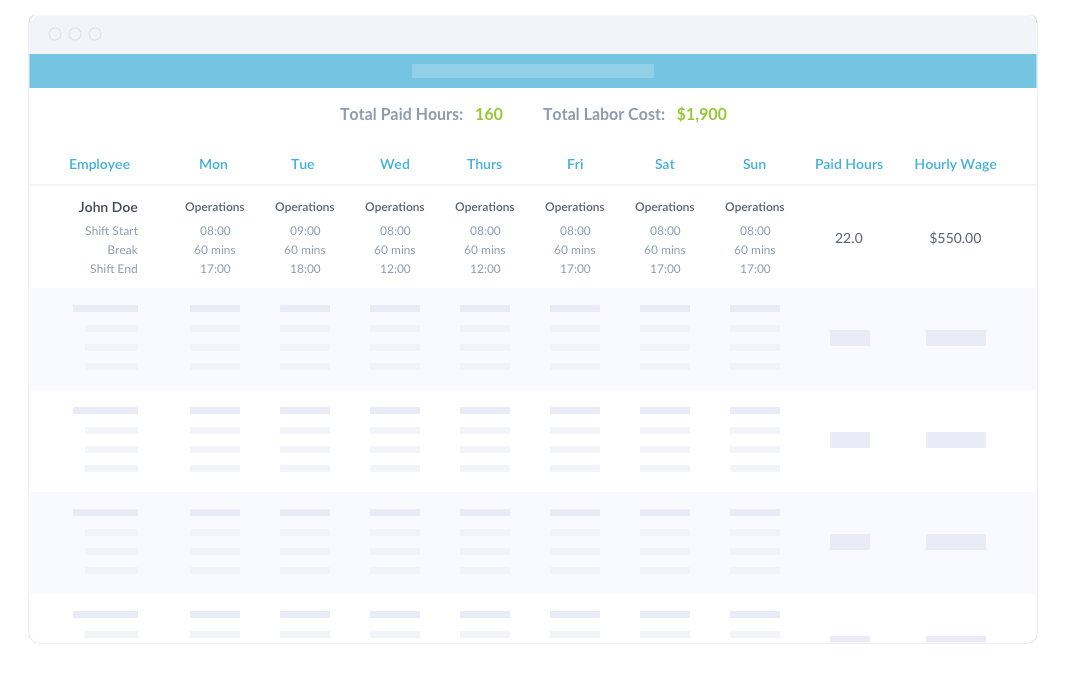Workforce planning is a systematic process that involves proactively analyzing current workforce gaps and forecasting future staffing needs to avoid potential shortages and surpluses of human capital.
It is based on the premise that a company can be staffed more efficiently if it takes initiative to regularly analyze and forecast its talent needs as well as the actual supply of talent that is or will be available.
Here are some of the benefits of workforce planning:
- Rapid talent replacement: Having the capability to rapidly figure out positions that are vacant due to sudden (or unavoidable) employee turnover so that production or services don’t miss a beat.
- A smooth business cycle: You can smooth out the cycles by developing processes that ramp up and down your talent inventory and work effectively during both good times and lean times.
- Lower turnover rates: Employees are continually groomed for new opportunities that fit their career interests and capabilities. They transition easily and rapidly to them.
- Lower labor costs: Labor costs are rapidly reduced as the right people are hired, at the right time, in the right place, and are managed correctly, all without the need for large-scale layoffs.
- Fewer future layoffs: Managing headcount ensures that the company won’t have a surplus of talent.
- Increased internal opportunities: Efficient workforce planning will free up HR professionals so that they can take advantage of talent-sourcing opportunities from a competitor as a way to find exceptional talent during tough economic times.
The primary reason for doing strategic workforce planning is economics. If done well, workforce planning will increase productivity, cut labor costs, and dramatically cut time-to-market because you’ll have the right number of people, with the right skills, in the right places, at the right time.
Workforce planning works because it forces everyone to begin looking toward the future, and prevents surprises. It requires managers to plan ahead and consider all eventualities.
While it is one of the most important issues that HR leaders and operations directors are talking about today, many have not gone beyond the talking stage as the task of actually implementing workforce planning is often seen as a daunting one. Don’t worry, we are here to break it down for you here so it’s not so intimidating.

Core components of workforce planning
While there is no standard “one size fits all” structure for the workforce planning process, below are some key elements of most plans, including some supplementary components that can and will work better for some companies than others.
The most common parts of a workforce planning model are:
- Workforce Analysis: Analysis of the company’s current supply of labor and its needs, as well as a forecast of future workforce needs and requirements
- Staffing Gap Analysis: Identification of gaps between the current workforce supply and demand, as well as gaps in the company’s present ability to anticipate future changes in workforce needs.
- Solution Deployment: Implementing and executing a plan to address staffing gaps
- Performance Assessment: Monitoring success metrics to ensure the workforce plan is meeting business needs
Being prepared is better than being surprised
If a company is more efficient, it can avoid the need for layoffs or panic hiring. By planning ahead, HR can provide managers with the right number of people, with the right skills, in the right place, and at the right time. Workforce planning might be more accurately called talent planning because it integrates the forecasting elements of each of the HR functions that relate to talent management–recruiting, retention, redeployment, and leadership and employee development.
Businesspeople who just wait and then attempt to react to current events will not thrive for very long. The new standard is to provide managers with warnings and action plans to combat full-blown problems before they become more than a blip on their radar.
The human resource management world is no different.
The rate of change in the talent market is dramatic. We now know how important talent is to the success of a business. It’s time to make the talent pipeline more efficient.
Many of the other overhead functions–like procurement, manufacturing, and even the mailroom–have developed effective “pipelines.” If human resources cannot develop effective pipelines, then the alternative option is to have its entire function outsourced to an external vendor.
HR should be aware of the business cycle
HR professionals often face the painful boom-and-bust cycle of budget cuts, rapid growth, and more budget cuts. What they want is stability. Unfortunately, the way that some HR people act or fail to act compounds the pain of the boom or bust phases.
Everyone knows that the business cycle has ups and downs. There are phases of growth and phases of recession; each seems to happen every few years. The surprising thing is that HR, rather than preparing customized approaches for the different phases of the business cycle, tends to do things the same way no matter what the economic climate, operating independently of the business cycle.
The main reason that HR suffers through these phases is that it has no business strategy or plan to participate in its company’s business cycle. Rather than seeing the big picture and setting a strategic direction, HR departments sometimes tend to coddiwomple with temporary programs that only address crises in the moment.
HR should have two distinct reasons for planning ahead. The first reason is to lessen the impact of the boom-and-bust cycle on the management and operation of the HR department itself. The second–and perhaps more important–reason for planning ahead is that HR manages the new hire pipeline for the organization. It’s crucial to maintain both that pipeline and the talent inventory at the right levels.
This is where workforce planning strategy comes in.
A closer look at workforce planning
To better prepare a company to handle current and future staffing needs, human resources should generally follow the four-step workforce planning process listed earlier in this article. Here is a closer look at what each of those steps entails:
1. Workforce Analysis
This first step in workforce planning involves assessing both the current state of your company’s workforce as well as its ability to address future changes in staffing needs. Additionally, it is also important here to analyze the current external labor market, company revenues, expenses, and growth opportunities.
There are three primary areas of the Workforce Analysis:
- Current labor supply & demand: checking the supply of labor the company currently has available, as well as the level of labor it currently demands.
- Forecast of future workforce needs: taking initiative on discovering what external and internal variables could impact workforce needs, and understanding where the company will need to be agile in the future to ensure staffing levels are always correct
- Skills and interest inventory: Identifying current and required job and competency needs as well employee skill sets.
From the workforce analysis, you should uncover a deeper understanding of your company’s current staffing situation, including its strengths, shortcomings, opportunities, and threats.
2. Staffing Gap Analysis
In this step, you take the information gathered from the workforce analysis and use it to pinpoint the talent gap between the company’s overall staffing needs and the identifiable supply of labor.
There are three parts to the staffing gap analysis:
- Surplus/shortage determination: Reviewing the current supply and demand of labor, as well as current and future workforce needs, and determining the presence of either a surplus or shortage of labor.
- Potential retirements: Figuring out the demographic of who is eligible, when they are eligible, who will replace them, and what alternative work arrangements are available that could prevent vacancy issues stemming from retirements.
- Talent action plan: Outline what specific actions all (HR or otherwise) managers will have to take in terms of talent management. The action plan designates responsibility and outlines the specific steps that should be taken in order to fill the talent pipeline, address skill gaps, and maintain the talent inventory at the levels required for the firm’s projected growth rate.Each action plan has a set of goals, an individual who is responsible for making sure the plan objectives are met, a budget, a timetable, and a measurable result.
3. Solution Deployment
This is where everything comes together. Once the workforce analysis is complete, gaps are determined, and a talent action plan is made, a solution is determined and then executed.
Deploying a workforce plan is not a once-and-done situation. It is an ongoing process built on agility and continuous improvement. Once current staffing gaps are filled and the overall workforce is strengthened, the deployment continues in the form of adjusting and adapting to changes in future needs.
Here are some of the main areas of solution deployment:
- Succession planning: Designating the progression plan for key positions.
- Leadership development: Designating high-potential employees; coaching; mentoring; rotating people into different projects.
- Talent recruiting: Estimating headcount, positions, location, timing, and more for new employees.
- Talent retention: Forecasting turnover rates; identifying current employees who are at risk and how to keep them.
- Redeployment: Deciding who is eligible for redeployment, and from where to where.
- Contingent workforce: Designating the percentage of employees who will be contingent, and in what positions
- Career path: Career counseling for employees to help them move up.
- Backfills: Designating key-position backups.
- Internal placement: Developing job-posting systems for internal employees to get a leg up on new openings.
- Outsourcing: Determining business functions that would be better accomplished by labor outside of the organization
- Contractors and consultants: Determining what new business requirements would be best met by specialized workers or consultants
4. Performance Assessment
Finally, the last step of a workforce plan is performance assessment. Again, this is an ongoing process, alongside solution deployment, in which select members of your organization monitor predetermined workforce success metrics to make sure strategic objectives are being met. These metrics should speak to if the workforce plan is actually benefiting the organization at all, and should indicate if the plan was flawed to begin with or if it is not being executed properly.
The future of workforce planning
Putting together an abstract workforce plan is one thing. Executing it across your entire workforce is another. Managers need the right tools and systems in place to monitor staffing levels, productivity, labor costs, and more.
While workforce planning has been around for a long time and has gone through many changes and multiple iterations, one thing is for certain: it is getting much easier.
Thanks to modern advances in workforce management software technology, workforce planning is becoming easier to visualize, deploy, and actively monitor.
Benefits of workforce management software
In order to execute effective workforce planning and achieve your business goals, HR leaders need a whole host of software solutions at their disposal. Chief among these is obviously HR software for talent and performance management. But other solutions are also required, including workforce management and labor forecasting software, both of which are extremely important to workforce planning.
Here are some of the ways workforce management and labor forecasting can streamline your workforce planning:
Everything on a single system
Nearly all the workforce planning data you need is housed in workforce management software. From time clock and scheduling data to employee records like pay rate and ob titles, everything is held in a single, cloud-based system optimized for easy access.
More visibility into labor costs
By combining scheduling and time tracking into a single system, workforce management software allows managers to leverage real-time data on labor costs. They can view costs per team, individual, week, or location to better understand where and how they are spending money on talent. Moreover, managers can view potential wage costs on schedules, and compare scheduled costs with actual costs on timesheets to pinpoint overspending.
Increased user self-service
Onboarding and retaining employees is critical to workforce planning. With workforce management software, employee self-service is maximized – users have access to a simple system to view schedules, request leave, pick up and swap shifts, clock in and out, and approve timesheets.
Easy insight into labor needs
The right labor forecasting software optimizes your workforce planning with AI and machine learning. It predicts demand and automatically matches labor ratios to that demand, making it easy to determine shortcomings in your supply of human capital. Clearly seeing where you lack the staff necessary to fulfill labor forecasts helps you hire more purposefully moving forward.
Comprehensive BI reporting
Managers can generate reports on historical wage costs, employee engagement, absenteeism, overtime, and more. These reports can be filtered by team, location, or job title, providing more clarity for managers when they are analyzing workforce trends.
Ensure labor compliance
Upon deploying a workforce plan, it is important to make sure your organization is complying with all necessary labor laws. It is particularly easy to misclassify contract workers, owe back pay, or violate various provisions of the Fair Labor Standards Act. Avoid all these issues when deploying your workforce plan with labor compliance software that schedules and pays employees accurately with the help of an extensive Wage & Hour Compliance library.
Optimize your workforce planning with Workforce.com
As a best-in-class workforce management platform, workforce planning is what we do. To learn more about how to streamline your business objectives with market-leading scheduling, compliance, and time tracking software, contact us today or sign up for a free trial.
FAQs
- What is workforce planning?
- It is a proactive and systematic process that involves analyzing the current supply of talent in your workforce, identifying gaps in your labor supply, forecasting future staffing needs, and developing shift plans to close gaps and meet budgets to avoid potential shortages and surpluses of human capital.
- Who does workforce planning?
- It is a collaborative effort between managers in multiple departments with a range of specialties since organizational alignment is important. Typically, HR and operations are most heavily involved.
- Why is workforce planning important?
- It is important for preventing over and understaffing as well as for building agility into a company’s talent management, retirement, and succession planning processes.
- What tool do I use for workforce planning?
- Typically you’ll need a robust HRIS system integrated with a specialized workforce management platform. The HRIS system should feature talent management, acquisition, onboarding, and payroll, while the workforce management platform should provide scheduling, time and attendance, and labor compliance.
- How does workforce management software help with workforce planning?
- Workforce management software helps managers execute and monitor the success of workforce planning. It allows businesses to schedule and track time accurately and compliantly. It also lets them view reports on labor costs, attendance, and engagement, which are all vital for keeping a business agile in its ability to forecast and react to changes in workforce needs.
- Is workforce planning difficult?
- No! Workforce planning generally involves four core steps and is continuously improved as businesses move forward. With the help of various software solutions, workforce planning is simple yet very rewarding.
- How is workforce planning different from talent acquisition?
- Talent acquisition is simply a small function of HR involving the identification and acquisition of workers for your company. Workforce planning is much broader, involving assessments of current talent supply, future talent supply needs, gaps in labor, and much more.






















